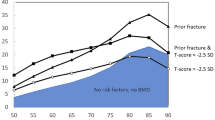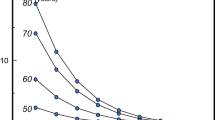Abstract
A comparison of hip fracture rates among nine countries (Canada, Chile, Finland, Hong Kong, Scotland, Sweden, Switzerland, the United States and Venezuela) was made using national hospital discharge data for the same time interval. The rates increased by age and were higher for females than males in all nine countries. When based on overall discharge rates, the incidence of hip fracture appeared high in three European countries (Finland, Scotland and Sweden) relative to the other countries. However, when transfer cases were removed and adjustments made for differences in case definition, the risk of hip fracture for both men and women was much similar among the four European and two North American countries, but higher than in Hong Kong. Rates of fracture were lowest in Venezuela and Chile, varying from three to 11 times less than for residents of the other seven countries. Although there are limitations in using hospital discharge data as a measure of incidence, the wide variation in the risk of hip fracture across the nine countries appears real but differences between North American and north European countries may not be as great as previously reported. Such cross-national comparisons may help clarify different etiologic hypotheses.
Similar content being viewed by others
References
Magaziner J, Simonsick EM, Kashner M et al. Survival experience of aged hip fracture patients. Am J Public Health 1989;79:274–278.
Roos LL, Fisher ES, Sharp SM, et al. Postsurgical mortality in Manitoba and New England. JAMA 1990;263:2453–2458.
Bonar SK, Tinetti ME, Speechley M, Cooney LM. Factors associated with short- versus long-term skilled nursing facility placement among community-living hip fracture patients. J Am Geriatr Soc 1990;39:1139–1144.
Maggi S, Kelsey JL, Kitvak J, Heyse SP. Incidence of hip fractures in the elderly: a cross-national analysis. Osteoporosis Int 1991;3:232–242.
Elffors I, Allander E, Kanis J et al. The variable incidence of hip fracture in southern Europe: the MEDOS study. Osteoporosis Int 1994;4:253–263.
Johnell O, Gullberg B, Allander E et al. The apparent incidence of hip fracture in Europe: a study of national register sources. Osteoporosis Int 1992;2:298–302.
Graves, EJ. Utilization of short-stay hospitals, US, 1988: annual summary. National Center for Health Statistics. Vital Health Stat, Series 13, No. 106. DHHS Pub No (PHS) 91-1767. Washington DC: GPO, 1991.
Honkanen R. Hospitalizations due to injuries in Finland in 1980. Publications of the University of Kuopio, Community Health Statistics and Reviews, No. 1/1990. Kuopio, Finland: University of Kuopio, 1990.
Ho SC, Bacon WE, Harris T et al. Comparison of hip fracture rates in Hong Kong and the US for 1988 through 1989. Am J Public Health 1993;83(5):692–697.
Director of Medical and Health Services. 1987–1988 Departmental Report. Hong Kong: Government Printer, 1988.
Melton LJ III, Ilstrup DM, Beckenbaugh RD, Riggs, BL. Hip fracture recurrence: a population-based study. Clin Orthop 1982;167:131–138.
Department of Health and Human Services. Health Information Policy Council: 1984 revision of the Uniform Hospital Discharge Data Set. Fed Reg 1985;50 (147):31038.
Jones MK. St. Anthony's DRG working guidebook, 1993. Alexandria, VA: St Anthony's Publishing.
Sirken MG, Shimizu BI, French DK, Brock DB. Manual on standards and procedures for reviewing statistical reports. Hyattsville, MD: National Center for Health Statistics, US Dept of Health and Human Services, 1990.
Shah BL. SESUDAAN: Standardized errors program for computing of standardized rates from sample survey data. Research Triangle Park, NC: Research Triangle Park Institute, 1981.
National Center for Health Statistics. Vital Statistics of the United States, 1990, vol II, mortality, part A (Technical Appendix). Washington: Public Health Service, 1994.
Bacon WE, Smith GS, Baker SP. Geographic variation in the occurrence of hip fractures among elderly white US population. Am J Public Health 1989;79:1556–1558.
Rodriguez JG, Sattin RW, Waxweiler RJ. Incidence of hip fractures, United States, 1970–83. Am J Prev Med 1989;5:175–181.
Smith GS, Langlois JA, Buechner JS. Methodological issues in using hospital discharge data to determine the incidence of hospitalized injuries. Am J Epidemiol 1991;134:1146–1158.
Parkkari J, Kannus P, Niemi S et al. Increasing age-adjusted incidence of hip fractures in Finland: the number and incidence of fractures in 1970–1991 and prediction for the future. Calcif Tissue 1994;55:342–345.
Institute of Medicine. Report of a study: reliability of hospital discharge abstracts. Washington, DC: National Academy of Sciences, 1977.
Evans JG. Fractured proximal femur in Newcastle upon Tyne. Age Ageing 1979;8:16–24.
Melton LJ III. Epidemiology of fractures. In Riggs BL, Melton LJ III (eds) Osteoporosis, etiology, diagnosis and management. New York: Raven Press, 1988;133–154.
Silverman SL, Madison RE. Decreased incidence of hip fracture in Hispanics, Asians and Blacks: California Hospital Discharge Data. Am J Public Health 1988;78:1482–1483.
Bauer RL. Ethnic differences in hip fracture: a reduced incidence in Mexican Americans. Am J Epidemiol 1989;127:145–149.
Solomon L. Osteoporosis and fracture of the femoral neck in the South African Bantu. J Bone Joint Surg [Br] 1968;50B:2–13.
Stott S, Gray DH. The incidence of femoral neck fracture in New Zealand. NZ Med J 1980;Jan 9:6–9.
Cummings SR, Black DM, Nevitt MC et al. Bone density at various sites for prediction of hip fractures. Lancet 1993;341:72–75.
Hui SL, Slemenda CW, Johnston CC. Baseline measurement of bone mass predicts fracture in White women. Ann Intern Med 1989;111:355–361.
Kelsey JL. Epidemiology of osteoporosis and associated fractures. J Bone Miner Res 1987;5:409.
Cummings SR, Kelsey JL, Nevitt MC et al. Epidemiology of osteoporosis and osteoporotic fractures. Epidemiol Rev 1985;7:178–208.
Kreiger N, Kelsey JL, Holford TR et al. An epidemiologic study of hip fractures in postmenopausal women. Am J Epidemiol 1982;116:141–148.
Grisso JA, Kelsey JL, Strom BL et al. Risk factors for falls as a cause of hip fractures in women. N Engl J Med 1991;324:1326–1331.
Lewinnek GG, Kelsey J, White AA, et al. The significance and a comparative analysis of the epidemiology of hip fractures. Clin Orthop 1980;152:35–43.
Ray WA, Griffin MR, West R et al. Incidence of hip fracture in Saskatchewan, Canada, 1976–1985. Am J Epidemiol 1990;131:502–509.
Paganini-Hill A, Chao A, Ross RK et al. Exercise and other factors in the prevention of hip fracture: the leisure world study. Epidemiology 1991;2:16–25.
Jacobsen SJ, Goldberg J, Miles TP et al. Regional variation in the incidence of hip fractures: US white women aged 65 years and older. JAMA 1990;264:500–502.
Cumming RG. Calcium intake and bone mass: a quantitative review of the evidence. Calcif Tissue Int 1990;47:194–201.
Johnston CC, Miller JZ, Slemenda CW et al. Calcium supplementation and increases in bone mineral density in children. N Engl J Med 1992;327:82–87.
Hoffman S, Grisso JA, Kelsey JL et al. Parity, lactation, and hip fracture. Osteoporosis Int 1993;3:171–176.
Alderman BW, Weiss NS, Daling JR et al. Reproductive history and postmenopausal risk of hip and forearm fracture. Am J Epidemiol 1986;124:262–267.
Cummings SR, Cauley JA, Palermo L et al. Racial differences in hip axis lengths might explain racial differences in rates of hip fractures. Osteoporosis Int 1994;4:226–229.
Nakamura T, Turner CH, Yoshikawa T et al. Do variations in hip geometry explain differences in hip fracture risk between Japanese and white Americans? J Bone Miner Res 1994;9:1071–1076.
Waher HW, Looker A, Walters L, Dunn WL. Racial and gender differences in the shape of the proximal femur. J Bone Miner Res 1994;9(Suppl 1):S401.
Author information
Authors and Affiliations
Rights and permissions
About this article
Cite this article
Bacon1, W.E., Maggi, S., Looker, A. et al. International comparison of hip fracture rates in 1988–89. Osteoporosis Int 6, 69–75 (1996). https://doi.org/10.1007/BF01626541
Received:
Accepted:
Issue Date:
DOI: https://doi.org/10.1007/BF01626541




